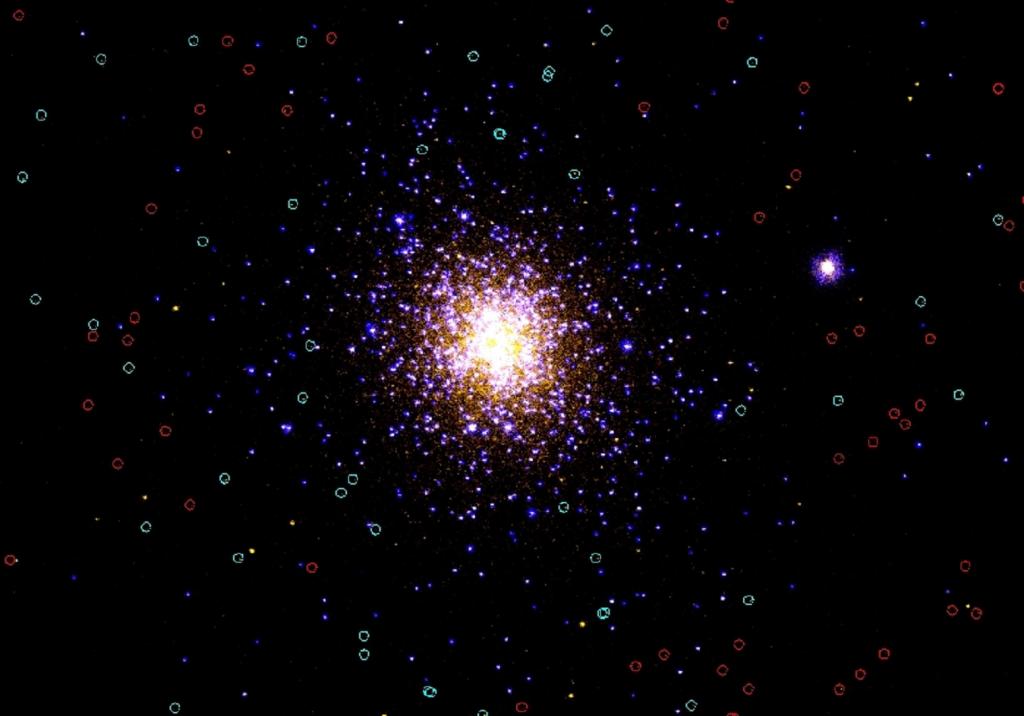
UV-BRIGHT STARS SPOTTED IN GLOBULAR STRUCTURE NGC 2808
CONTEXT
- Recently, astronomers have spotted rare hot Ultra Violet (UV)-bright stars in the massive intriguing globular cluster in the Milky Way Galaxy called NGC 2808. India’s first multi-wavelength space satellite AstroSat helped astronomers in this.
MORE ABOUT NEWS
-
- About 34 UV-bright stars were found to be members of the globular cluster (NGC 2808). One of the UV-bright stars was found to be about 3000 times brighter than the Sun with a surface temperature of about 1,00,000 K.
- Hot UV-bright stars have been distinguished from the relatively cooler red giant and main-sequence stars.
- Most of the stars were found to have evolved from a solar stage called the horizontal branch stars with hardly any outer envelope. Thus, they were bound to skip the last major phase of life called the asymptotic giant phase (it is one of the last major phases in the life of stars) and directly become dead remnants or white dwarfs.
SIGNIFICANCE
- Properties of Stars: The findings will help in determining properties of these stars such as their surface temperatures, luminosities and radii.
- Evolution of Stars: These present excellent laboratories where astronomers can understand how stars evolve through various phases between their birth and death.
- Death of star: It is not clear how these stars end their lives as not many of them are detected in these fast-evolving phases, making their study crucial.
- UV radiations: UV-bright stars are speculated to be the reason for the ultraviolet radiation coming from old stellar systems.
SEVEN MAIN STAGES OF A STAR
- Stars come in a variety of masses and the mass determines how radiantly the star will shine and how it dies. Massive stars transform into supernovae, neutron stars and black holes while average stars like the sun, end life as a white dwarf surrounded by a disappearing planetary nebula. All stars, irrespective of their size, follow the same 7 stage cycle, they start as a gas cloud and end as a star remnant.
- Giant Gas Cloud – A star originates from a large cloud of gas. The temperature in the cloud is low enough for the synthesis of molecules. The Orion cloud complex in the Orion system is an example of a star in this stage of life.
- Protostar – When the gas particles in the molecular cloud run into each other, heat energy is produced. This results in the formation of a warm clump of molecules referred to as the Protostar.
- T-Tauri Phase – A T-Tauri star begins when materials stop falling into the Protostar and release tremendous amounts of energy. The mean temperature of the Tauri star isn’t enough to support nuclear fusion at its core.
- Main Sequence – The main sequence phase is the stage in development where the core temperature reaches the point for the fusion to commence. In this process, the protons of hydrogen are converted into atoms of helium.
- Red Giant – A star converts hydrogen atoms into helium over its course of life at its core. Eventually, the hydrogen fuel runs out, and the internal reaction stops. Without the reactions occurring at the core, a star contracts inward through gravity causing it to expand. As it expands, the star first becomes a subgiant star and then a red giant. Red giants have cooler surfaces than the main-sequence star, and because of this, they appear red than yellow.
- The Fusion of Heavier Elements – Helium molecules fuse at the core, as the star expands. The energy of this reaction prevents the core from collapsing. The core shrinks and begins fusing carbon, once the helium fusion ends.
- Supernovae and Planetary Nebulae – Most of the star material is blasted away into space, but the core implodes into a neutron star or a singularity known as the black hole. Less massive stars don’t explode, their cores contract instead into a tiny, hot star known as the white dwarf while the outer material drifts away. Stars tinier than the sun, don’t have enough mass to burn with anything but a red glow during their main sequence. These red dwarves are difficult to spot. But, these may be the most common stars that can burn for trillions of years.
